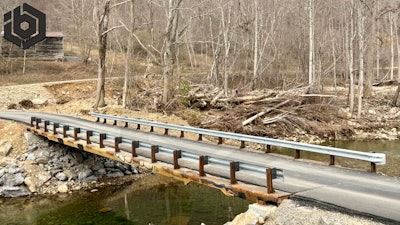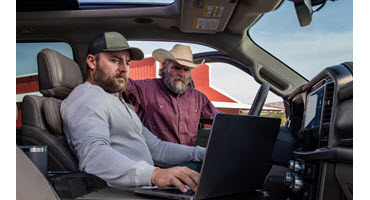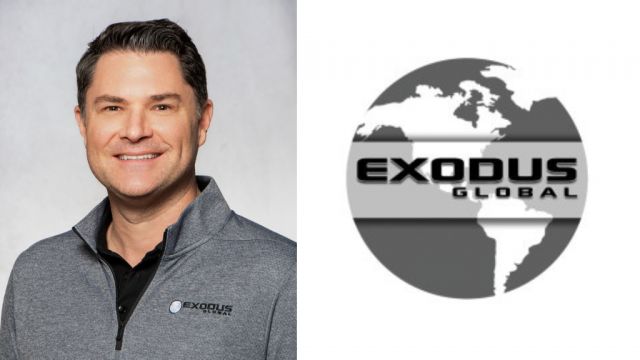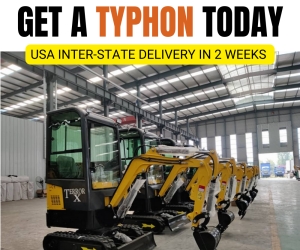Bridges Made of Railcars Reconnecting North Carolina After Hurricane Helene (Video)
Innovative Bridge Company has installed over 60 bridges made from old railcars in North Carolina since Hurricane Helene hit.

Last year’s Hurricane Helene caused billions of dollars’ worth of damage along the East Coast, including a mudslide that incapacitated part of Interstate 40 in North Carolina.
The resulting damage has disconnected many communities, leading the North Carolina Department of Transportation to find quick ways to reconnect them. One of the solutions is dissembled, decommissioned railcars.
Watch a video of a 90-foot railcar bridge installation in North Carolina at the end of this story.
Lee Roberts owns Innovative Bridge Company in Petal, Mississippi, which designs, fabricates, installs and uninstalls railcar bridges and tank car metal culverts across the U.S. The company has been particularly busy in North Carolina since Helene hit. The first of its bridges went up in October in Asheville, and over 60 are currently in use today.
Roberts says some of the initial work was done in Avery County to replace downed bridges for Christmas tree farms, which were hit badly by the hurricane.
Public reaction to the swift installation of these new bridges has been overwhelmingly positive, he says.
 A rail car bridge in Elk Park, North Carolina.Innovative Bridge Company
A rail car bridge in Elk Park, North Carolina.Innovative Bridge Company
“I've never seen so many smiles,” he says. “When we pull up somewhere, they're so grateful, it's unbelievable. We haven’t even got out the truck yet, and we got food, we got drinks. They’re the most grateful people you've ever seen in your life. And that's worth more than anything to it. We used to say we deliver access, but up here, we're delivering smiles, because these people have been walking across these creeks and rivers to their house on a daily basis.”
IBC also recently signed a contract with a private company in North Carolina to begin work on installing several hundred residential railcar bridges. He says thousands of private bridges were downed in the storm, and IBC is capable of installing up to 20 per week.
Manufacturing & Installing
IBC purchases and sells railcars that can no longer be used by railroads.
“A rail car has only got 50 years of life, and once that 50 years is up, it doesn’t matter if it's made one trip or made 10,000 trips,” he says. “It is, by the government standards, the end of life. So, every year there’s thousands of railcars coming out.
“Not all of them are flat cars. Some of them are tank cars, some of them are gondolas, some of them are grain cars. But they’re constantly coming out. So, we have to take the good with the bad … anything that we can make a deck out of, that is structurally sound, we will make a deck out of it.”
Roberts and his team inspect the cars for damage and rust. Some end up being scrapped or cut down, such as removing 30 feet of damaged metal from a 90-foot car to make a 60-foot bridge. One hard and fast rule is any railcar that ever derailed is considered structurally unsound.
 A rail car bridge in Pensacola, North Carolina.Innovative Bridge Company
A rail car bridge in Pensacola, North Carolina.Innovative Bridge Company
By combining the railcars, IBC is able to achieve different bridge lengths. It recently installed a 270-foot bridge composed of six 90-foot railcar beds. It also uses 50-, 60- and 70-foot cars as well.
Pricing on IBC bridges varies, particularly given the circumstances under which they’re installed in North Carolina. Most IBC bridges going up in the state are single-lane structures.
“On Highway 19, there’s like 17 miles that are completely gone, and there’s only one lane of traffic,” says Roberts. “We’re having to take them up the mountain with wheel loaders, one going backwards and one going forwards, going 12 to 15 miles up the mountain. Most of the cost is the transportation.”
Setting up an IBC bridge can be done quickly and with a small crew of six machines and eight workers, meaning they’re usually in and out within one day.
“A lot of times, we’ve got precast abutments,” Roberts says. “These precast abutments are 20 feet long, 3 feet wide and 18 inches deep, one solid piece of concrete. We can drop one of them on both sides, set the railcar bridge on it, tie it into the abutment, weld our plate on it, put our guardrails on it, and within a day, you've got a bridge that you’re driving over.”
Because the North Carolina bridges went up in the winter, IBC also paved over them to avoid a problem with ice forming.
Taking down a bridge is just a reversal of the process, only the guardrails are left on when excavators pull the bridge out and take it away.
Where Did the Idea Come From?
Roberts’ history with the railroad industry goes back to his on-the-road trucking days, which allowed him to establish relationships that would help him later with founding IBC.
“I used to own a trucking company, and I hauled windmills all over the United States,” he says. “So, I was already used to moving big things. Then we teamed up with a railroad. We'd rail them so far and then transport them by truck the rest of the way. So, we had a good relationship with the railroad there.
 An example of a double-wide rail car bridge in Century, Florida.Innovative Bridge Company
An example of a double-wide rail car bridge in Century, Florida.Innovative Bridge Company
“My brother also worked for the railroad, and that kind of got me a foot in the door to getting the cars. Because you can’t call up there and just say, ‘Hey, I want one car.’ You know, they want somebody that can handle volume. When they’ve got a bunch of cars, they only make one phone call and make those cars disappear, because it’s a problem for them. They need them off their books. They're paying storage on them and need them gone.”
Roberts already knew the concept of turning a railcar into a bridge was sound, having seen it used in California after earthquakes.
He began simply selling the bridges, but leasing turned into a lucrative opportunity after power companies began to approach him. They were hoping to solve a unique problem that required temporary structures.
“They [the companies] own the right of way, but they don't own the land, but they got to have access to it,” Roberts says. “Well, I got approached on leasing them, and they told me what they paid to lease a bridge, and that's more than I paid for a house. So, we started renting them. Now we’ve got a rental fleet of around 150, and we're constantly installing them, bringing them back, moving them from here to there.
“A lot of construction companies, with all this wetland and all the permits and everything, now they just call us. … It shortens their process up of permitting and everything else on these large developments, because they're not disturbing the wetlands.”
Roberts says the fleet of bridges set up for the Avery County Christmas tree farms are rentals, but the bridges commissioned by NCDOT have been purchased.

 machineryasia
machineryasia 








